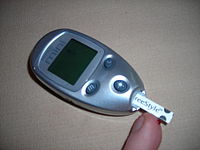
Photo from wikipedia
This study was designed to improve blood glucose level predictability and future hypoglycemic and hyperglycemic event alerts through a novel patient‐specific supervised‐machine‐learning (SML) analysis of glucose level based on a… Click to show full abstract
This study was designed to improve blood glucose level predictability and future hypoglycemic and hyperglycemic event alerts through a novel patient‐specific supervised‐machine‐learning (SML) analysis of glucose level based on a continuous‐glucose‐monitoring system (CGM) that needs no human intervention, and minimises false‐positive alerts. The CGM data over 7 to 50 non‐consecutive days from 11 type‐1 diabetic patients aged 18 to 39 with a mean HbA1C of 7.5% ± 1.2% were analysed using four SML models. The algorithm was constructed to choose the best‐fit model for each patient. Several statistical parameters were calculated to aggregate the magnitudes of the prediction errors. The personalised solutions provided by the algorithm were effective in predicting glucose levels 30 minutes after the last measurement. The average root‐mean‐square‐error was 20.48 mg/dL and the average absolute‐mean‐error was 15.36 mg/dL when the best‐fit model was selected for each patient. Using the best‐fit‐model, the true‐positive‐hypoglycemia‐prediction‐rate was 64%, whereas the false‐positive‐ rate was 4.0%, and the false‐negative‐rate was 0.015%. Similar results were found even when only CGM samples below 70 were considered. The true‐positive‐hyperglycemia‐prediction‐rate was 61%. State‐of‐the‐art SML tools are effective in predicting the glucose level values of patients with type‐1diabetes and notifying these patients of future hypoglycemic and hyperglycemic events, thus improving glycemic control. The algorithm can be used to improve the calculation of the basal insulin rate and bolus insulin, and suitable for a closed loop “artificial pancreas” system. The algorithm provides a personalised medical solution that can successfully identify the best‐fit method for each patient.
Journal Title: Diabetes/Metabolism Research and Reviews
Year Published: 2020
Link to full text (if available)
Share on Social Media: Sign Up to like & get
recommendations!